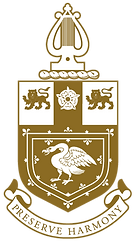Autograph manuscript of A Marching Song
(Follow the Colours)
by Sir Edward Elgar (1857-1934)
Presented below is an autograph manuscript of A Marching Song, by Sir Edward Elgar (1857-1934). Composed to words by Captain William de Courcy Stretton, it was written following a commission from the Worshipful Company of Musicians.
It was a Liveryman, Mr William Henry Ash (future President of the Livery Club, Senior Warden and Gold Medalist) that suggested and indeed funded the commission of this patriotic Marching Song (reported at a Court meeting in April 1906). William Ash had originally suggested that an open competition be undertaken that would lead to:
i) the production of a Marching Song
ii) a Violin piece (with String Accompaniment)
iii) the funds to publish works by a British Composer.
However, it was decided to offer a commission to Sir Edward Elgar (for the Marching Song featured below) and one to Sir Alexander Mackenzie for the Violin and Orchestral piece (Click Here to see his manuscript score). The £20 funds from William Ash for publication purposes were eventually awarded to a Mr Bath (who was at the time studying at the R.A.M.) for four songs he had composed (further information on, or whereabouts of these songs is unknown).
It is said that Alfred Henry Littleton (Chairman of Novello's Music Publishers) had to plead with Elgar to go ahead with the commission of the Marching Song, as there was much that Elgar disliked about the idea. Reportedly, some of the more jingoistic members of the Court hoped it would rank with Rule Britannia and be sung by squads of every battalion in the Army. Its premiere was given by a Kneller Hall Band for the Court on 28 April 1908 and its first public performance was at the Royal Albert Hall on Empire Day, 24 May 1908.
In 1914 the song was adapted by the composer for solo and optional male chorus, orchestrated and re-published as Follow The Colours. In this form it was heard at the Royal Albert Hall on 10 October 1914. The mood is at best cheerful optimism, at worst bombastic. Shown below is a collection of postcards produced by the Company (click to expand).
The chorus generally reinforces the solo singer in the second and fourth lines of each verse, and joins in the refrain. The accompaniment, for full orchestra, is an example of brilliant but sensitive writing for the large percussion section, which consists of three timpani, side drum, triangle, bass drum and cymbals. Sadly, A Marching Song never achieved its anticipated popularity and it remains a real Elgarian rarity.
Click on the red triangle below, to hear a recording of this piece taken from a 2010 CD.
This recording of Elgar’s Follow the Colours (from Dutton Epoch CDLX 7246) appears here by courtesy of Dutton Epoch.
Roderick Williams (baritone) with the BBC Concert Orchestra conducted by Martin Yates.
(P) 2010 Dutton Epoch
© 2010 Dutton Epoch
Please visit www.duttonvocalion.co.uk where this recording can be purchased on CD (cover shown right)

Shown below are the 16 pages of MSS held by the Company. Click on an image to expand and scroll though - click on "Go to link" to expand that particular page as a pdf image:
















: :


